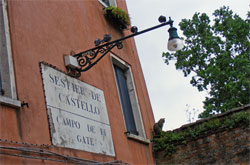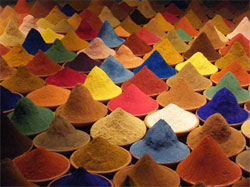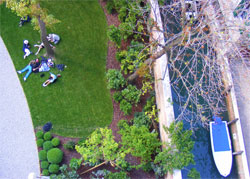




CdP
31 May 2013
It’s uncanny the extent to which the hill on which CdP sits can act as a watershed – or perhaps I mean a ‘weathershed’. We were on a train in Bologna station last night when our friend Adri rang. He lives on the Chiusi side of our hill. “You can’t imagine what has been going on here for the past hour,” he said. “Hailstones the size of golf balls. There’s not a plant standing.”
The scene when we reached Chiusi station was bizzarre. There was 10cm of ice piled up on each side of the road. It looked like there had been a snow storm. And the thermometer said three degrees. May 30. Three degrees.
But the ‘snow’ ended at a very precise point on the road up to CdP, beyond which it was merely wet. Everything below that line was battered, diced leaves spread over every surface and, we’re told, baby olives, paches and grapes stripped from every branch. All the roses that had braved the cool, wet weather and come out were in ribbons on the ground. Yet over here on the Perugia side – hardly a kilometre away – nothing.
I’m not foolish enough to gloat about this. I’m looking out of the kitchen window now – mid-afternoon – at a sky which is black as pitch, save for a ray of light illuminating the big olive tree. Doors are rattling around the house as gusts of wind rip by. A ribbon of destruction could just as easily sweep up our valley at any moment.
This year’s Venice Biennale is perhaps the one I’ve enjoyed most. Certainly it’s the art one I’ve enjoyed most. Granted, what with one thing and another I hardly scratched the surface of the national pavilions in the Giardini. But what’s in the Arsenale was fascinating and involving and stimulating in a way I’d not experienced before. I heard some people bemoaning its backwards-looking agenda. Perhaps inevitably, it was that which captured me. Because while I have – I have to admit – many problems with contemporary art, there was a logical progression here which, for me, made much of the contemporary stuff easier to digest. And I appreciated that effort to involve the likes of me.
Venice was grey, often damp, unseasonably cold. But it was full of people, and people we know. We arrived and hid out immediately at a favourite haunt of ours on the Giudecca: Alla Palanca, a tiny bar where a smiling family serves wonderful lunches. At one table was a British journalist we know and his family, on another a friend from Rome. At Da Bonifazio for coffee and fantastic cakes, another friend, an American who used to live in Rome. Etc etc.
In piazza San Marco and around, the hordes in their see-through placky macs followed guides, looking skywards with a disgruntled air and barely feigning interest in the tour elucidations. They appeared oblivious, too, to the way their lines were intersected by art-talking trendsters in thick-rimmed glasses, haircuts hurrying to San Zaccaria to hop on the vaporetto for the Arsenale or Giardini – worlds so far apart they weren’t even clashing, just passing on different planes.
We were in San Marco for the Manet show at the Doge’s Palace: we felt the need to ease outselves gently into our art overdose.
I’m not sure that I’ve ever given much thought to Manet, except to quite like some things in the Quai d’Orsay and be aware in a very general sense of his contribution to the development of modern painting. But seeing him in this excellently curated exhibition was an eye-opener. The show plays very much on his relationship with the worùs by Italian grand masters he came across on his travels. Putting his Olympia side by side with Titian’s Venus of Urbino is such an obvious, marvellous thing to do that it’s amazing it has never happened before. The similarities and differences are telling. But so is Carpaccio’s Ladies waiting for their husbands to return from the hunt next to Le Balcon, and Manet’s party pieces next to those of Pietro Longhi too. What comes across in Manet is his tactile use of paint as part of what is being depicted. There were two small canvasses of peonies which were quite ravishing.
So what did grab me in the Arsenale? The general lay-out was pleasing: I liked the way the space had been used, despite the fact that it was so chopped-up that you lost the immensity of the corderia entirely. There was a lot of fascinating photography, including fantastic close-ups of Nigerian hairdos right at the beginning. There was a lot of video, much of which I had to take a deep breath over; the exceptions were a long long bank of small monitors showing very simple everyday scenes by a Chinese artist (names, I’m afraid, often escaped me) which I liked a lot and one totally gripping piece made by a French woman called Camille Henrot (I took a photo of that one) who spent a year rifling through the Smithsonian’s video archive and spliced together something gripping backed by a Last Poets-style rhythmical sound track.
Rather against my will, I found myself liking the grey drooping figures in Pawel Althamer’s Venetians: I’ve seen them described as ‘ghoulish’ but I found them quite good company after I’d wandered through them for a bit. There were some ornate, wild, totally compulsive tapestries woven by a Portuguese man in an asylum, and some strangely endearing semi-porn photos of a 1950s-‘60s American – unknown as an artist in his life time – of his gorgeous wife in b-movie star get-up.
Of the national pavilions in the Arsenale, I loved the IILA one though this may have something to do with the wonderfully overpowering scent coming off the piles of spices that occupy the whole centre of the floor; I found the Indonesian show fascinating, and enjoyed the huge upturned oscillating tree branch plus photos in the Latvian section.
But the Biennale wasn’t, in fact, the reason we were in Venice: it was merely a lucky coincidence. L was there to try out a new hotel, a hotel which opened officially after we left. The Aman Grand Canal Venice is only the third of this luxury group’s offerings in Europe and the first in Italy. The hotel is all as you’d hope and expect from this Asian outfit: elegant luxury masquerading as simplicity, painstaking attention to detail. Not all the details were to my taste: extending the low-chair theme into the dining room felt like a recipe for indigestion to me, and at breakfast I prefer a buffet requiring autopilot choices to being forced to make conversation and coherent decisions with sweetly encouraging staff.
But the palazzo itself made up for any of my doubts, and, wisely, Aman has done little to detract from the overwhelming presence of the structure itself. Some of the wall fabrics have been replaced, with exquisite Rubelli reproductions. The stucchi and murals have been beautifully restored. The two gardens (and this is the only Grand Canal palazzo with two) have been spruced up… rather boringly in my opinion but it’s early days yet. And the furnishings which have necessarily been added are a perfect blend of minimal-tasteful elegance with extreme low key.
Moreover the owner of palazzo Papadopoli – glass designer Giberto Arrivabene – has been ‘incorporated’ into this hotel-manifestation of his family pile, as an aristocratic presence sweeping about the place and effortlessly demonstrating how it should be experienced. “I’m selecting which chair I’m going to die in,” he said when we met him in the bar. Not that he’s likely to croak any time soon. And I suspect that his restless spirit might keep him far from the bar once the hotel is fully operational and full of guests: I should think that suffering fools gladly is not one of Gibe’s talents.



